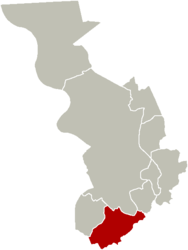Wilrijk
| Wilrijk | ||
|---|---|---|
|
||
| Coordinates: 51°10′N 04°23′E / 51.167°N 4.383°E | ||
| Country | Belgium | |
| Region | Flemish Region | |
| Community | Flemish Community | |
| Province | Antwerp | |
| Arrondissement | Antwerp | |
| Municipality | Antwerp | |
| Postal codes | 2610 | |
| Area codes | 03 | |
| Website | http://www.wilrijk.be | |
Wilrijk (former, original spelling: Wilrijck) is a district of the municipality and city of Antwerp in the Belgian province of Antwerp. Wilrijk had been a separate municipality before January 1, 1983; the enlarged municipality of Antwerp was decentralized in 2000 and Wilrijk became one of the city's nine districts.
This suburb is also known as the Goat village, because of its Goat parade. Every five years this parade attracts a lot of tourists. The next one will be held in 2020.
Although it is now part of the city of Antwerp, Wilrijk has kept its own distinct atmosphere. A mixture of modern and older neighbourhoods, this suburb has a good balance between residencial, commercial and industrial activities. Its facilities for sport and recreation in a green environment make it a desirable area in which to live. This area was already inhabited in 600 BC. This has been shown by the excavation of a Celtic burial site in Wilrijk, which is the oldest sign of civilization yet discovered in the region around Antwerp.
The total area of Wilrijk is 13.61 km² and it has 38.220 inhabitants (2004).
Probably the first time people lived in this area was around 600 BC. In 1003 the first document appeared in which the name uuilrika was mentioned. This document tells about the existence in 743 AD of a community living around the central square in Wilrijk which is called Bist. The triangular shape of the Bist shows the Frankish past of Wilrijk. One of the current theories is that the name Wilrijk is actually derived from the Gallo-Roman word Villariacum (meaning: "Part of the domain of a Roman Villa"). Evidence for the existence of a Roman villa was found in a nearby village Kontich.
After the closing of the Zwyn and the decay of Bruges, the city of Antwerp became of more importance. At the end of the 15th century the foreign trading gilds moved from the city of Bruges to Antwerp. These "foreigner" were well received by the families in Antwerp. Some of the richer people from Antwerp escaped their busy lives in the center of the city and, attracted by the rural character of Wilrijk (and other towns surrounding Antwerp), started building large houses (little castles) there. These houses are called Hoven van plaisantie, some of these still exist even today: Klaverblad, Schoonselhof, Ieperman, Steytelinck, Middelheim, De Brandt, Hof Ter Beke. Others didn't survive: Jezuietenhof, Ooievaarsnest (Oversnes), Hoonsnest (Hondsnest of Hof van Van Dael), Groenenborgerhof, Elsdonkhof, Standonk, Korenbloem. But their names still remain in the consciousness of the people living in Wilrijk through names of streets and neighbourhoods.
...
Wikipedia


